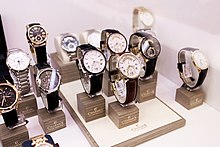
In fashion, an accessory is an item used to contribute, in a secondary manner, to an individual's outfit. Accessories are often chosen to complete an outfit and complement the wearer's look. They have the capacity to further express an individual's identity and personality. Accessories come in different shapes, sizes, hues, etc. The term came into use in the 16th century.
Types

Fashion accessories may be loosely categorized into two general areas: carried accessories and worn accessories. Carried accessories include purses and handbags, hand fans, parasols and umbrellas, wallets, canes, and ceremonial swords. Worn accessories include cravats, ties, hats, bonnets, belts and suspenders, gloves, muffs, necklaces, bracelets, watches, eyewear, sashes, shawls, scarves, lanyards, socks, pins, piercings, rings, stockings and hair ties.
Shoes, boots, sneakers, and all types of footwear are not accessories but 'wear for the foot'. The type of accessory that an individual chooses to wear or carry to complement their outfit can be determined by several factors, including the specific context of where the individual is going. For example, if an individual is going to work their choice of accessory would differ from someone who is going out to drinks or dinner; thus depending on work or play different accessories would be chosen. Similarly, an individual's economic status, religious and cultural background would also be a contributing factor.
History

In Victorian fashion accessories such as fans, parasols and gloves held significance for how women experienced gender, race, and class. In this era, there was a trend for women to adopt, or aspire to, a more leisurely lifestyle. Consequently, gloves were often used by women to cover their hands and mask any signs of labour. One fashion accessory commonly worn by women in Victorian England was the slide bracelet. Slide bracelets were worn after the wrist watch came into fashion.
During the early 16th century, in Italy hat badges were worn by civilian men of higher social status as a decorative item, in imitation of the cap badges worn by the invading military. Hat badges were often worn in conjunction with a decorative sword and hilt. Hat badges were fashioned after plaquettes and often depicted a scene with personal relevance to the wearer.
See also
Notes
- "Many watch manufacturers have capitalized on the acceptance of the watch as a fashion accessory and have entered into licensing agreements with designers."
References
- ^ Valerie Cumming; C. W. Cunnington; P. E. Cunnington (15 November 2010). The Dictionary of Fashion History. Berg. p. 1. ISBN 978-1-84788-533-3. Retrieved 9 January 2012.
- "accessory", Wiktionary, the free dictionary, 2023-11-29, retrieved 2024-02-03
- Diamond, J.; Diamond, E. (2013). The World of Fashion. Bloomsbury Academic. p. 348. ISBN 978-1-60901-527-5. Retrieved 2021-04-27.
- "Clothing & Accessories". National Museum of American History. Archived from the original on 2018-08-27. Retrieved 2018-08-27.
- Ariel Beaujot (June 2012). Victorian Fashion Accessories. Berg. p. 1. ISBN 9781847886828.
- "Slide Bracelet". Lang Antique Jewelry University.
- Marika Leino (7 December 2012). Fashion, Devotion and Contemplation : The Status and Functions of Italian Renaissance Plaquettes. Peter Lang AG. p. 1. ISBN 9783039110681.
External links
 Media related to Clothing accessories at Wikimedia Commons
Media related to Clothing accessories at Wikimedia Commons
| Clothing | |||||||||
|---|---|---|---|---|---|---|---|---|---|
| Headwear | |||||||||
| Neckwear | |||||||||
| Underwear and lingerie |
| ||||||||
| Tops | |||||||||
| Bottoms |
| ||||||||
| Full-Body Wear |
| ||||||||
| Coats and outerwear |
| ||||||||
| Nightwear | |||||||||
| Swimwear | |||||||||
| Legwear | |||||||||
| Footwear | |||||||||
| Accessories |
| ||||||||
| Dress codes |
| ||||||||
| Related | |||||||||

